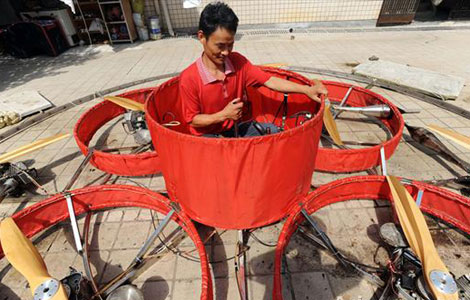Call made for new appraisals of artifacts
Updated: 2011-08-24 08:35
By Zhang Kun (China Daily)
|
|||||||||||
SHANGHAI - A second appraisal is being sought for two ceramic artifacts held at a museum in Hangzhou, capital of East China's Zhejiang province, after experts expressed doubts about the pieces' authenticity.
 |
|
A girl admires a pot suspected of being a fake while visiting a museum in Hangzhou, Zhejiang province, on Aug 20.[Photo/China Daily] |
The items, a big pot decorated with emblem patterns and a drum with black and white glaze, are among a group of 600 pieces that Ding Yangzhen gave to the Southern Song Official Kiln Ceramics Museum in 2005.
For the donation, Ding received a reward of 15 million yuan ($2.3 million) from the Hangzhou government.
Yang Jingsong, researcher of the Palace Museum, was the first to question the authenticity of the two antiques. Yang said the pot, deemed "the king of pots" and one of the most well-known exhibits at the Hangzhou museum, showed no evidence that it had come from the Changsha Kiln, its supposed place of origin.
In addition, the design of the artifact did not make sense. Pots of that type were often meant to contain alcohol. Yet, the handle of the piece in the museum's collection appears to be not strong enough to remain intact were the pot filled with liquid.
The other piece, a drum in black and white, is said to be "too coarse to be considered to have come from an official kiln in the Southern Song Dynasty (1127-1279)".
During that dynasty, the production of pottery and porcelain rose to a new height in China. Pieces coming from the official kiln, which produced high-class chinaware solely for imperial consumption, were recognized as being the most valuable in existence and were the most prone to being counterfeited.
Two of the four scholars who had previously appraised the batch of antiques from Ding - Zhang Pusheng, a researcher from the Nanjing Museum, and Zhu Ji, from the Yangzhou Museum of Jiangsu province - told the media again on Monday that the pots were genuine.
Zhang, who now lives in Australia, told Xinhua Daily: "It's normal to challenge the appraisal of an antique, but Yang's questions are not very professional." He said scientific equipment should be used to further examine the pieces and produce more convincing results.
Shen Jialu, a Shanghai-based writer and antique collector, argued that the Changsha Kiln was in use during the Tang Dynasty (AD 618-907) and that the pot, even if it is proved to be authentic, did not belong to the Southern Song period.
The Changsha Kiln churned out a large number of ceramics for export, as well as for daily use in the Chinese market, he explained. "They were not fine pieces that were to be buried in tombs, and most of them are broken," Shen said. "It's unlikely that a giant pot like this would stay in perfect condition until now."
Shortly after acquiring the pots, museum officials invited four experts to determine whether they were authentic. The conclusion was affirmative.
Even so, documents show the test was carried out in 2007 - two years after the museum had acquired the pieces - and that only three experts signed their names in support of the artifacts' authenticity.
Zhu Ji, one of the three experts, told Xinhua Daily that he is now unsure about the authenticity question. He once suggested that more experts be called in to make further independent appraisals of the pieces.
According to an antique collector based in Shanghai, who asked to be anonymous, Ding, the donor, has had many dealings in the antiques market and is said to have sold fake ceramics in Shanghai.
Ding himself says he bought the pots from someone who excavated them from a dry riverbed.
"I am pretty sure it is authentic," he said. "I have a better one with me. I decided to donate the less perfect one."
He once took the pots to an appraisal institution in Beijing, but the result failed to satisfy him. Even so, he is confident of the artifacts' authenticity.
The pot and the drum are still on display at the museum.
- Live Report: Gadhafi says withdrawal tactical move
- Quake hits US, no major damage
- Tougher penalties for sea pollution
- 5 detained over toxic waste dumping
- 26 trapped after coal mine floods
- Japan Prime Minister on way out
- Live Report: Gadhafi on the run as rebels fight
- More trains slow to improve safety
Hot Topics
Anti-Gay, Giant Panda, Subway, High Speed Train, Coal Mine, High Temperature, Rainstorm, Sino-US, Oil Spill, Zhu Min
Editor's Picks

|

|

|

|

|

|






